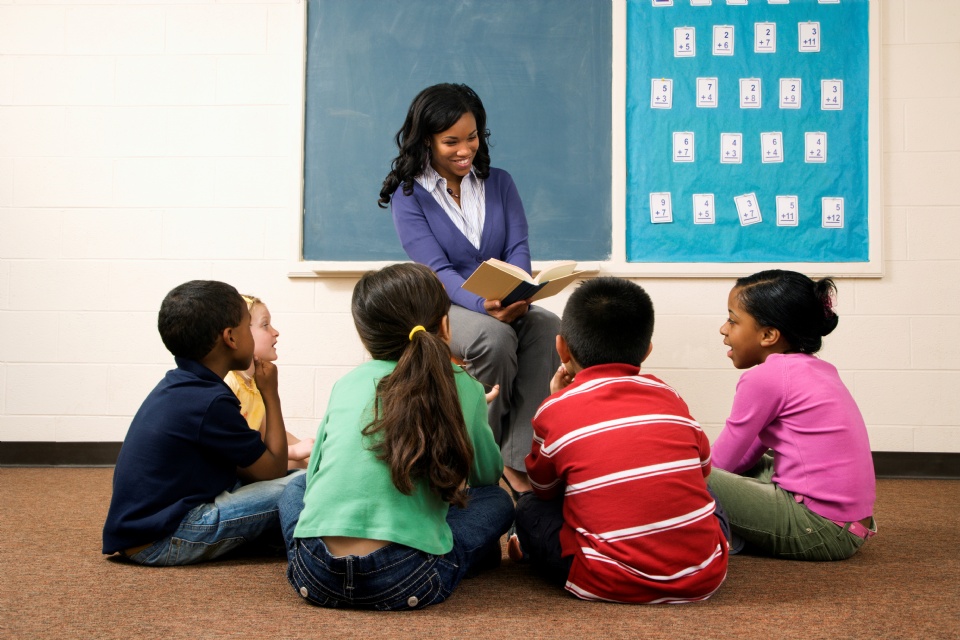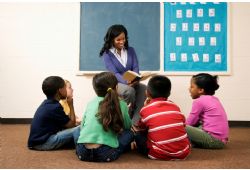Storytelling is an ancient art that can
be extremely beneficial in modern times. There is so much knowledge to be
shared with today’s youth and storytelling can be one of the most effective
ways to do it. Telling and listening to stories can help people sharpen their
listening skills and learn more about the world around them. For children, it
can be one of the most powerful educational tools they have access to.
Kit Brennan, author, award-winning
playwright and former teacher for children and young adults in theatre and
storytelling, says the art of storytelling teaches young people how to use
their imagination and gives them more confidence when speaking in front of other
people. It also teaches them how to tell stories in a logical manner.
“Storytelling helps children and adults organize their minds,” she says.
Leslie Ogilvie is a teacher and
librarian at Jack Callahan Public School in Lindsay, Ontario. Last year, she taught
a workshop at the Toronto Storytelling Festival. In her presentation there, she
described how storytelling can help children’s development of oral
communication, language, creative writing and reading skills. Storytelling also
helps with emotional development because it teaches core values such as
empathy, courage and kindness, which can then be applied to everyday life.
Storytelling is an unparalleled art to
help with children’s concentration. “In a time and a culture where kids are
used to things changing every five seconds, my kids can sit and give [me their]
undivided attention for 45 minutes while listening to a story,” says Ogilvie.
When telling stories, Ogilvie uses
vocabulary from the original folk tales to give children a sense of the narrative
and to show them how to present coherent stories. She says once children are
familiar with more classic stories, they can easily develop their own. This is
something that children get very excited about. Brennan agrees, saying even
very shy kids will come out of their shell to talk about their lives.
Storytelling can be used throughout a
child’s education and can be integrated within the school curriculum. That
being said, different ages call for different approaches. Brennan says that
seven to nine-year-olds like to stay with traditional stories, but that 11 to
12-year-olds love to push boundaries and experiment with style and content.
Brennan says for teenagers, “the sky is the limit as far as the story goes.”
There are many creative ways to bring
storytelling into the classroom for any topic – it doesn’t always have to do
with reading and writing. For example, when Ogilvie teaches history, she uses
stories based on facts as tools to teach all the information that is required. Stories work because as Ogilvie says, “students
just remember narratives so much better, even with math – students will
remember math concepts better if they have a story. It gives them a hook to
hang their hats.”
While storytelling and performance
are two different things, they can easily be intertwined. “For children, it
helps them to free up their imagination and think outside of the box. Drama and
storytelling can help connect all of those things,” says Brennan.
For teachers who don’t know where to
start, Brennan recommends books specifically about storytelling for children,
such as Stories in the Classroom;
Storytelling, Reading Aloud, and Roleplaying with Children by Bob Barton
and David W. Booth, Creative
Storytelling; Building Community, Changing Lives by Jack Zipes or Development Through Drama by Brian Way.
Ogilvie encourages parents to use
storytelling at home, as well, and suggests teachers bring in storytellers from
the community, such as the parents or grandparents of their students.
Grants are another resource that can
help teachers and storytellers to share their craft. Both Ogilvie and Brennan
organized storytelling projects with the help of governmental and
organizational grants. In Quebec, project grants for either professional
development or innovation programs are available for teachers, library
personnel and administrators who want to develop student achievement in English
schools.
Even though traditional storytelling may
seem ancient compared to modern forms of entertainment, the benefits it has for
children are immense.

 In The Latest Issue:Latest Issue:
In The Latest Issue:Latest Issue:
- A Bittersweet Farewell
- The new Laval Aquatic Co...
- The End of an Era:
Articles
Calendar
Virtual- ANNUAL TEACHER APPRECIATION CONTEST
- APPUI LAVAL
- ARTS & CULTURE
- CAMPS
- CAR GUIDE
- CCIL
- CENTENNIAL ACADEMY
- CHARITY FUNDRAISING
- CITYTV
- COSMODÔME
- COMMUNITY CONNECTIONS
- COVER STORY
- DINA DIMITRATOS
- ÉCOLE SUPÉRIEURE DE BALLET DU QUÉBEC
- EDITORIALS
- ÉDUCALOI
- EDUCATION
- EMPLOYMENT & ENTREPRENEURSHIP
- FÊTE DE LA FAMILLE
- FÊTE DU QUARTIER SAINT-BRUNO
- FAMILIES
- FESTIVAL LAVAL LAUGHS
- FÊTE DE QUARTIER VAL-DES-BRISES
- FINANCES
- GLI CUMBARE
- GROUPE RENO-EXPERT
- HEALTH & WELL-BEING
- 30 MINUTE HIT
- ANXIETY
- CHILDREN`S HEALTH & WELLNESS
- CLOSE AID
- DENTAL WELLNESS
- EXTREME EVOLUTION SPORTS CENTRE
- FONDATION CITÉ DE LA SANTÉ
- GENERAL
- HEARING HEALTH
- MESSAGES FROM THE HEALTH AGENCY OF CANADA
- MENTAL HEALTH
- SEXUALITY
- SOCIAL INTEGRATION
- SPECIAL NEEDS
- TEENS
- THE NUTRITION CORNER
- THE NUTRITION CORNER - RECIPES
- VACATION DESTINATION
- WOMEN'S FITNESS
- WOMEN'S HEALTH
- HILTON MONTREAL/LAVAL
- HOME & GARDEN
- INTERNATIONAL WOMEN'S DAY
- JAGUAR LAVAL
- LAVAL À VÉLO
- LAVAL FAMILIES TV SHOW
- LAVAL FAMILIES MAGAZINE CARES
- LAVAL URBAN IN NATURE
- LE PARCOURS DES HÉROS
- LES PETITS GOURMETS DANS MA COUR
- LEON'S FURNITURE
- LEONARDO DA VINCI CENTRE
- LFM PREMIERES
- LIFE BALANCE
- M.P. PROFILE
- MISS EDGAR'S AND MISS CRAMP'S SCHOOL
- MISSING CHILDREN'S NETWORK
- NETFOLIE
- NORTH STAR ACADEMY LAVAL
- OUTFRONT MEDIA
- PASSION SOCCER
- PARC DE LA RIVIÈRE-DES-MILLE-ÎLES
- PÂTISSERIE ST-MARTIN
- PIZZERIA LÌOLÀ
- PLACE BELL
- PORTRAITS OF YOUR MNA'S
- ROCKET DE LAVAL
- SACRED HEART SCHOOL
- SCOTIA BANK
- SHERATON LAVAL HOTEL
- SOCIÉTÉ ALZHEIMER LAVAL
- STATION 55
- STL
- SUBARU DE LAVAL
- TECHNOLOGY
- TEDXLAVAL
- TODAY`S LAURENTIANS AND LANAUDIÈRE
- TODAY`S LAVAL
- WARNER MUSIC
- THIS ISSUE
- MOST RECENT
Magazine
The Benefits of Telling Stories in Class
Articles ~e 105,7 Rythme FM 4 chemins Annual Teacher Appreciation Contest Appui Laval Arts & Culture Ballet Eddy Toussaint Camps THIS ISSUE MORE...
CONTESTS Enter our contests
CONTESTS Enter our contests
CALENDAR
Events & Activities
COMMUNITY Posts Events
PUBLICATIONS Our Magazine Family Resource Directory
LFM BUSINESS NETWORK Learn more
COUPONS Click to save!
COMMUNITY Posts Events
PUBLICATIONS Our Magazine Family Resource Directory
LFM BUSINESS NETWORK Learn more
COUPONS Click to save!
SUBSCRIPTIONS
Subscribe to the magazine
Un-Subscribe
E-NEWSLETTER Subscribe to our E-newsletter Un-Subscribe
WRITE FOR US Guidelines & Submissions
POLLS Vote today!
E-NEWSLETTER Subscribe to our E-newsletter Un-Subscribe
WRITE FOR US Guidelines & Submissions
POLLS Vote today!
ADVERTISERS
How to & Media guide
Pay your LFM invoice
SUGGESTIONS Reader's Survey Suggest a Listing
LFM About Us Our Mission Giving Back Contact Us
SUGGESTIONS Reader's Survey Suggest a Listing
LFM About Us Our Mission Giving Back Contact Us
 PICK-UP LOCATIONS
Get a copy of LFM!
PICK-UP LOCATIONS
Get a copy of LFM!
TERMS & CONDITIONS Privacy | Terms
ISSN (ONLINE) 2291-1677
ISSN (PRINT) 2291-1677
Website by ZENxDESIGN



 BY:
BY: 
Tweet
Share